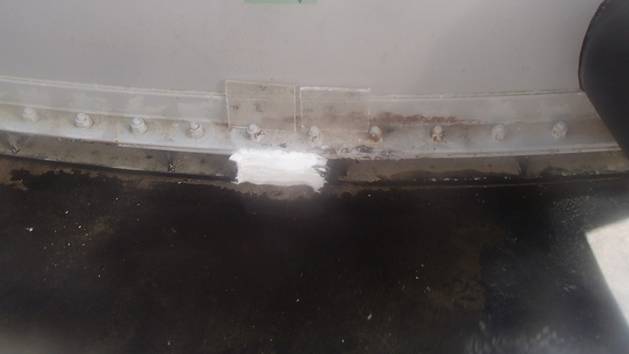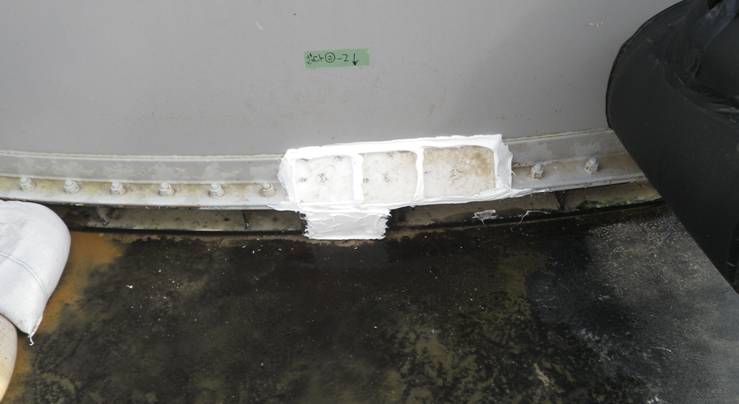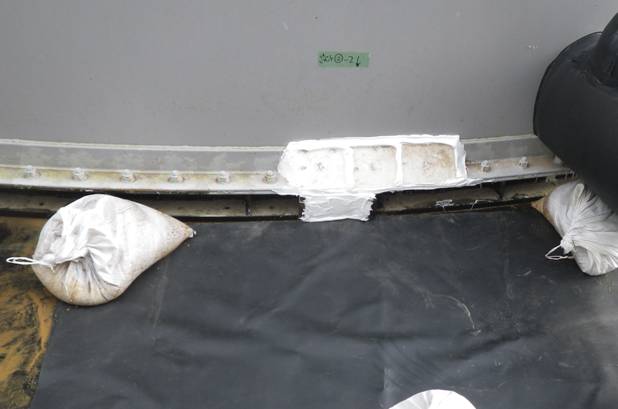The images don't give you much confidence and may make you fear for the safety of workers from beta radiation exposure on skin who would be asked to perform this task on potentially over 350 huge tanks.
But the beta radiation (measured at 5 centimeter and expressed in 70 micrometer dose equivalent) did go down.
The experiment details, from TEPCO's Handout for the Press 9/5/2013 on H3 Area tank radiation shielding experiment:
1. Apply sealing material (which looks like putty) to the flange.
2. Place one to three acrylic sheets (15 x 10 x 1 centimeter).
3. Place two layers of rubber sheets (1.5m x 1m x 3mm) on the concrete (and put sand bags to hold them down).
Result:
2,200 mSv/hr --> 30 mSv/hr
500 mSv/hr --> 15 mSv/hr
70 mSv/hr --> 10 mSv/hr
TEPCO has already said they will replace these assembled tanks with the welded tanks, and these measures should be temporary. But in the process of containing the accident and decommissioning somehow, "temporary" measures tend to be permanently temporary until something bad happens.
Since the radiation here is almost all beta radiation, if workers are required to do this work of applying putty and placing the acrylic sheets on all high-radiation spots, I'm afraid the radiation exposure could be significant, despite several layers of gloves.
TEPCO may be the master of cheap (quasi-)solutions, but that, I'm afraid, is one of the characteristics of the Japanese. I'm sure it is shared by many other peoples in the world, but I've been seeing it repeatedly in the past two and a half years to deal with the nuclear accident and radiation contamination.
Construction of impermeable walls by freezing the soil around the reactor/turbine buildings is to be funded by the national government, but the debate among net citizens is almost all about the cost. There are many, supposedly engineers, who are claiming they can do other methods cheaply and quickly at a fraction of the cost of frozen walls.
There was a similar argument when AREVA's co-precipitation decontamination system and Kurion's cesium absorption system were first adopted soon after the start of the accident in March 2011. Many Japanese people, scientists, engineers and media questioned why the Japanese government was paying foreign companies a ton of money, and grumbled that an all-Japan team of companies like Hitachi, Toshiba with the help from Japanese scientists and engineers could do the same thing much better and much much cheaper.
Hitachi and Toshiba later delivered such systems. Hitachi built the Reverse Osmosis Apparatus that leaked high-beta water to the ocean (March 2012). Toshiba built SARRY, which is just as reliable as Kurion and prone to unexpected stoppage and leaks including pinhole leak from corrosion caused by the bad weld.
Price tags do not indicate the superiority or inferiority of technologies, of course.






 Tokyo Time
Tokyo Time
![[Most Recent Quotes from www.kitco.com]](http://www.kitconet.com/charts/metals/gold/t24_au_en_usoz_2.gif)


1 comments:
So when and what are they planning to do with the Strontium-90? Are they going to process it out as they transfer the water to new holding tanks?
Post a Comment